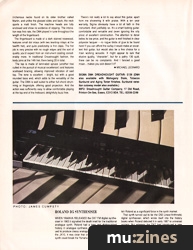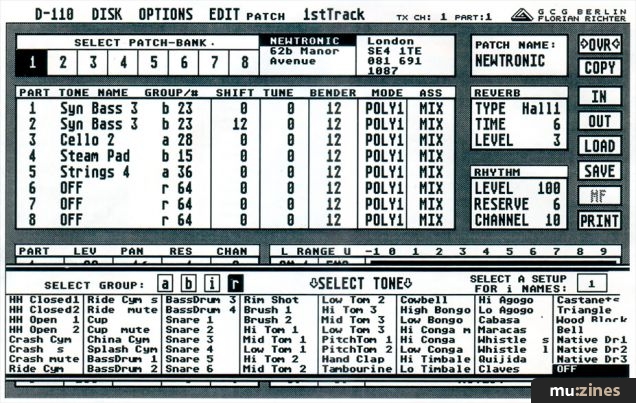Magazine Archive
Home -> Magazines -> Issues -> Articles in this issue -> View
Article Group: | |
Roland D5 Synthesiser | |
Article from Phaze 1, July 1989 | |

Image credit: James Cumpsty
WHEN YAMAHA RELEASED the DX7 FM digital synthesiser in 1983 it signalled the death knell for the traditional analogue synth. Roland had a long and distinguished history in analogue synthesis, but although they continued to produce classy analogue synths like the JX8P and the JX10, it was clear that only an innovative all-digital synth could break the Yamaha stranglehold and re-establish Roland as a significant force in the synth market.
That synth turned out to be the D50 Linear/Arithmetic digital synthesiser, which wrote itself into the history books when Roland debuted it in early 1987 to universal acclaim. But whereas the DX7 had introduced a new quality of synthesised sound befitting the synth's all-digital status, with the D50 Roland did their best to preserve an analogue type of sound. Similarly, while the DX7 foisted a new programming system onto musicians, the D50 adopted the altogether more familiar programming model of analogue-styled subtractive synthesis.
So what was so new about the D50? The fact that it provided 100 short 16-bit PCM samples stored permanently onboard. These included all manner of percussion instruments together with the attack segments of such instruments as piano, harpsichord, organ, electric and acoustic guitar, electric and upright bass, flute, clarinet, trumpet, trombone, violin and cello. Think about it for a moment. Even when you hear a very short note it's still possible to distinguish a violin from a saxophone, a guitar from a piano. It's the attack of an instrument which gives it much of its character, and sampling can reproduce this much more authentically than synthesis. Thus the D50 combined the acoustic realism of sampling with the electronic versatility of synthesis, and in so doing defined a new direction for digital synths which has since been adopted, in various guises, by companies such as Kawai (with the K1), Korg (with the M1) and Ensoniq (with the SQ80 and now the VFX). And as if this wasn't enough, the D50 introduced onboard programmable digital reverb and delay, a development which has been picked up on most notably by Korg's M1 and Ensoniq's new VFX.
Now you're probably wondering where the D5 fits into all this. What does it mean to be a D50 without a zero on the end? Quite simply, the D5 is the latest in a long line of L/A synths which Roland have subsequently released to capitalise on the success of the D50 and to help recoup the massive cost which research and development of a new synthesis system inevitably entails. We've had synth expanders in the form of the D550, MT32 and D110, and synths in the form of the D10, D20 and now the D5. Whereas the D550 was an expander version of the D50, the next addition to the pack in the form of the budget MT32 surprised everyone by (a) being a great deal smaller than the D50, and (b) being eight-part multi-timbral (ie. it can play eight different sounds — timbres — at the same time). In addition it has a dedicated 'drumkit' section of 30 clean, bright and punchy drum and percussion samples onboard (taken from Roland's own TR626 drum machine), a development which has started yet another trend.
At £450 the MT32 is still the cheapest option for anyone wanting an L/A instrument (and especially now that you can pick them up second-hand for around £300), but it has a number of shortcomings which haven't endeared it to more demanding users, namely its lack of front-panel programmability, its inability to store programmed sounds onboard through powerdown, its lack of individual audio outputs and its unconventional shape (ie. it won't fit into a 19" rack). The subsequent (and more expensive: £599) D110 not only rectifies all these problems, it provides more 'drumkit' samples (63 in all) and more and improved PCM instrument samples (256 in all); however, front-panel programming awkwardness means that you're better off using computer-based editing software such as Steinberg's Synthworks generic D editor for the Atari ST.
After these expanders came the D10 and D20 five-octave keyboard synths, essentially the same internally as the D110 but very different on the outside. The D20 (£1245) represents Roland's attempt at what is generally known as a 'workstation', that is a keyboard instrument which includes a sequencer, multi-timbral capability, 'drumkit' sounds, onboard digital effects, and even an onboard disk drive. Of course the expanders already have some of these features, but the D20 adds a nine-track sequencer (eight instruments and one rhythm) and a disk drive. The cheaper D10 (£850) forgoes the disk drive and the sequencer (all bar the rhythm track), but in all other respects is the same as the D20. Both instruments lose the individual audio outs of the D110.
The D5 represents a further scaling down from the D20 and the D10, both in price (£251 less than the D10) and capabilities — though in terms of sonic capability it's essentially the same as these instruments. And the good news is that it can read D10/D20 sound cards via its rear-panel card slot.
The most obvious difference is the reduced casing size, and the modified front-panel layout. Gone is the D10's rhythm track, although the 'drumkit' sounds and eight-part multi-timbral capability are still there (however, you really need to be using the D5 in conjunction with an external MIDI sequencer to make the most of these features).
However, added to the D5 are four Patch effects: Chord Play, Harmony, Chase and Arpeggio. These are selectable from the synth's front panel and programmable for each sound in Performance mode. Basically, Chord Play and Harmony offer forms of chordal accompaniment to notes you play in the upper part of the keyboard, while Chase is a form of delay and Arpeggio plays the notes of a held-down chord consecutively in up, down or random order. Altogether these are interesting performance effects, but to my mind, at least, not a major attraction.
If you've played one of Roland's L/A synths before, you'll have a pretty good idea of what the D5 sounds like, because it offers no surprises. There are delicate, shimmering bell-like sounds; a variety of tuned and ethnic percussion sounds; breathy choirs and flutes; bass sounds which can be fat and raspy, rich and warm or bright and sharp; warm phased electric pianos; harsh and metallic electric pianos; bright, punchy synth brass; full-sounding ensemble string sounds... However, overall, while the D5's sounds excel at being bright and tinkly or bright and raspy, qualities such as depth and smoothness are not always so evident (possibly more a consequence of the programming than of the programming system).
Perhaps the most significant difference between the D5 and its more expensive relatives becomes apparent when you play the new synth: gone are the onboard digital effects which have been part of every L/A instrument from the D50 onwards. You could buy a stand-alone digital reverb unit for the price difference (or less) between the D5 and the D10; it won't necessarily give you all the convenience and flexibility of onboard digital effects, but there again you can use a stand-alone reverb unit with any instruments you own. Another point to bear in mind if you're interested in using computer-based generic L/A patch-editing software is that editing differences between the D5 and D10/D20 will entail amendments to such software before it's properly compatible. So what exactly is the sound architecture of the D5? There are 256 onboard PCM samples divided into rhythm, attack, sustain, decay and special-effect categories. Together with the sawtooth and square waveforms and digital filtering which form the basis of the D5's synthesis capabilities, these are the raw sound material from which the synth's sounds are shaped. A Partial is a PCM sampled sound or a synth sound with associated LEO, filter and amplitude parameters (though no filtering in the case of the PCM samples), while a Tone can consist of from 1-4 Partials, in any combination of PCM and synthesised sounds. In Performance mode a Patch consists of a pair of Tones in Whole, Dual or Split keyboard modes (the latter with programmable splitpoint). In this way you could layer up to eight Partials (though this would only give you four-note polyphony) or have a split texture such as bass in the left hand and piano in the right.
In Multi Timbral mode, each Part (1-8) can be assigned a Timbre, which is in fact a single Tone. To play the Timbre of a particular Part on the keyboard, you must assign the keyboard's MIDI transmit channel to the same channel as the relevant Part.
Onboard the D5 are 128 Patches, 128 Timbres, 128 Preset Tones (ie. preset combinations of PCM and synthesised sounds) and 64 Programmable Tones, while a further 128 Patches, 128 Timbres and 64 Programmable Tones can be stored on a RAM card.
Polyphony (ie. the number of voices) on the D5 is not a straightforward matter. You can play up to 32 Partials at once, which means that if you're playing a single-Partial Patch or Timbre then you've got 32-note polyphony. But if you're playing a four-Partial Patch or Timbre then you're down to eight-note polyphony. In Multi Timbral mode the situation isn't so clear-cut, as Partials are assigned dynamically across the nine Parts (each active PCM percussion sample in the Rhythm section counts as one Partial).
When you bring out as many variations on a theme as Roland have done with L/A synthesis, choosing between them can be a tricky business. The addition of the four Patch effects is no real substitute for the omission of digital reverb and delay processing, which I found disappointing, especially as the much cheaper MT32 manages to include them. There again, if you already possess a digital reverb, or perhaps one of the new generation of multi-effects processors, the D5 might be just right for you. But is there any competition from elsewhere? Well, price-wise the D5 and Kawai's K1 are direct contenders, and as there are certain similarities of approach you'd be well advised to compare the two. Meanwhile, Yamaha are still weighing in with FM synthesis in the form of the user-friendly YS100, again at an equivalent price.
ROLAND D5 SYNTHESISER: £599 inc VAT
INFO: Roland UK, (Contact Details).
Also featuring gear in this article

Rock 'n' Roll and D-5
(MIC Aug 89)
Roland D5 - L/A Synthesiser
(MT Jul 89)
Roland D5
(SOS Sep 89)
Browse category: Synthesizer > Roland
Featuring related gear
Geerdes D-Series Editor
(MT Mar 92)
Patchwork
(MT Feb 90)
Browse category: Software: Editor/Librarian > Geerdes
Browse category: Synthesizer > Roland
Publisher: Phaze 1 - Phaze 1 Publishing
The current copyright owner/s of this content may differ from the originally published copyright notice.
More details on copyright ownership...
Review
Feature by Simon Trask
Help Support The Things You Love
mu:zines is the result of thousands of hours of effort, and will require many thousands more going forward to reach our goals of getting all this content online.
If you value this resource, you can support this project - it really helps!
Donations for November 2025
Issues donated this month: 0
New issues that have been donated or scanned for us this month.
Funds donated this month: £0.00
All donations and support are gratefully appreciated - thank you.
Magazines Needed - Can You Help?
Do you have any of these magazine issues?
If so, and you can donate, lend or scan them to help complete our archive, please get in touch via the Contribute page - thanks!












